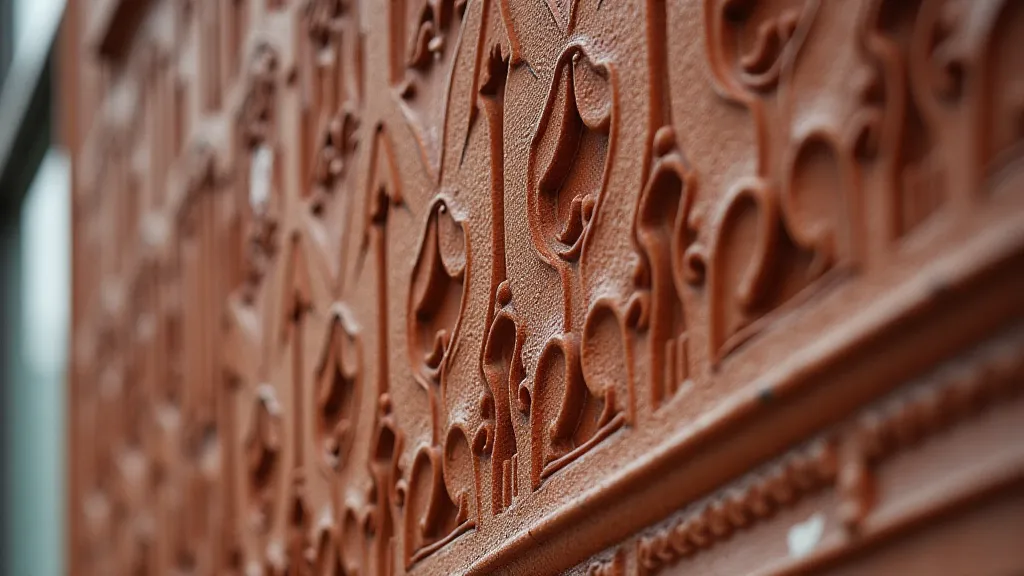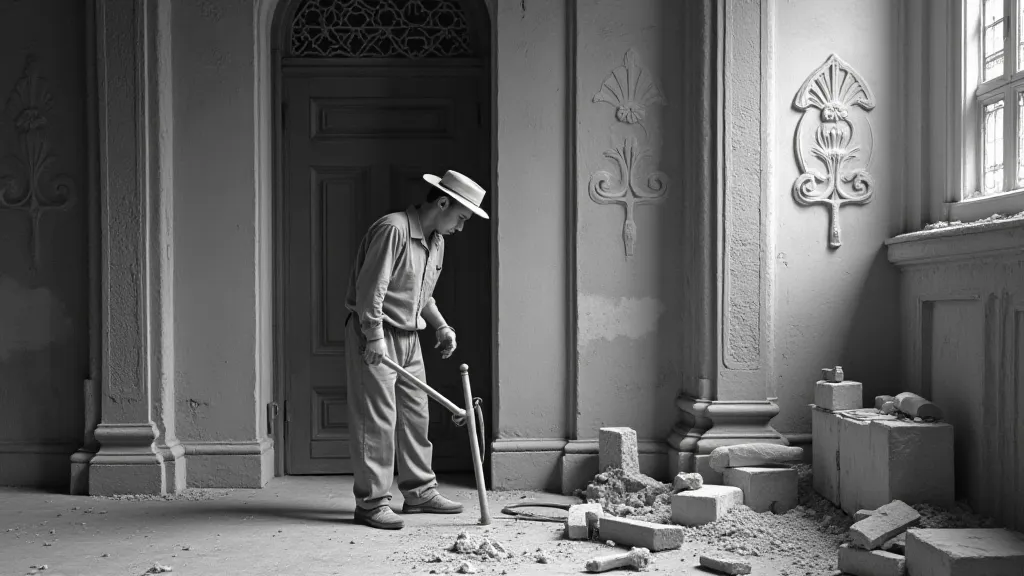The Weight of Silence: Art Deco's Unsung Sanctuary of the Common Man
We often picture Art Deco as a shimmering mirage of opulent hotels, soaring skyscrapers adorned with gold leaf, and the lavish interiors of the wealthy elite. The Chrysler Building, the Empire State Building – they’re icons, undeniably beautiful, and instantly recognizable. But this perception, while alluring, masks a far more profound and democratized story. It obscures the fact that Art Deco, in its essence, wasn’t solely a style for the privileged; it was, and remains, a testament to dignified design accessible to the common man. It's a silent architecture, whispering of aspirations, resilience, and the quiet beauty of everyday life.
My own fascination with Art Deco began not with a grand hotel lobby, but with a local library. A sturdy, brick building in my hometown, it wasn’t particularly flashy. Yet, the geometric detailing above the entrance, the stylized floral motifs carved into the facade, and the subtle bronze accents spoke volumes. There was a sense of purpose, a solidity that resonated deep within me. It felt like a building built to endure, to serve, and to offer solace, regardless of socioeconomic status. That library, unassuming as it was, became my portal to a world of forgotten beauty.
The Rise of Accessible Ornamentation
The 1920s and 30s were a period of immense social and technological change. The First World War had reshaped the world order, while the burgeoning industrial revolution brought new materials and construction techniques. Traditional architectural styles felt inadequate to express the optimism and forward momentum of the era. Enter Art Deco, drawing inspiration from ancient Egypt, Aztec motifs, and the streamlined efficiency of the machine age. But unlike its predecessor, Beaux-Arts, which prioritized grandeur and lavishness, Art Deco sought a more accessible form of ornamentation.
The key lay in the materials. While expensive materials like exotic woods and rare stones were certainly used in high-end projects, Art Deco architects increasingly embraced readily available materials like brick, terra cotta, and reinforced concrete. These materials, often embellished with geometric patterns and stylized detailing, could be used to create buildings that were both aesthetically pleasing and relatively affordable. The advent of pre-cast concrete elements was particularly transformative, allowing for intricate ornamentation to be mass-produced and incorporated into buildings with greater ease and economy. The processes behind the ageing and patina that develop on these surfaces, a phenomenon explored in greater depth in articles about the palette of decay, added another layer of character and beauty to these structures.

The Concrete Poetry of Public Works
The Great Depression brought a renewed focus on public works projects. Governments across the world sought to stimulate economies and provide employment, and architecture played a vital role. Art Deco’s adaptability and relatively efficient construction methods made it a perfect fit for these endeavors. Think of the streamlined bus terminals, the imposing post offices, the elegant courthouses, and the community centers that sprung up across the landscape. These weren't just buildings; they were symbols of hope and progress, designed to serve the needs of the people.
Consider, for instance, the numerous apartment buildings constructed in cities like New York, Chicago, and Miami. While some were undoubtedly luxurious, many were built as affordable housing, providing decent living conditions for working-class families. The Art Deco detailing – the geometric friezes, the stylized railings, the decorative panels – wasn't simply superficial ornamentation; it was an integral part of the building’s identity, conveying a sense of pride and dignity for its residents. These structures, often bearing the marks of time and the passage of industry, frequently evoke a sense of melancholy beauty, a subject explored further in pieces detailing concrete dreams and the misunderstood poetry of Brutalism.
I recently visited a former Art Deco apartment complex in Detroit, a city once synonymous with automotive industry boom and now grappling with the challenges of urban decay. The building itself, though weathered and showing its age, retained a remarkable beauty. The original mosaic tilework in the lobby, the decorative metalwork on the windows – these details weren't removed or replaced in a misguided attempt to modernize the building. They remained, a testament to the enduring power of design.
The Craftsmanship of an Era
What truly sets Art Deco architecture apart is the level of craftsmanship involved. Each building was a collaborative effort, bringing together architects, engineers, stonemasons, tile makers, and countless other skilled artisans. The intricate carvings, the elaborate tilework, the meticulously crafted metal details – these were not mass-produced; they were the result of countless hours of painstaking labor.
Think of the bronze ornamentation, often incorporating stylized representations of animals, plants, or geometric patterns. Or the glazed terra cotta panels, each one carefully molded and fired to create a unique and visually striking element. These were not just decorative flourishes; they were integral parts of the building’s structure, contributing to its overall aesthetic appeal and structural integrity.
I’m an amateur accordion collector, and there's a direct parallel to be drawn with the craftsmanship of Art Deco buildings. Antique accordions, especially those from the 1920s and 30s, were meticulously crafted. The bellows were painstakingly stitched, the keys precisely aligned, the wood carefully selected and finished. You can feel the care and attention that went into their creation. Just as with an accordion, examining an Art Deco building reveals a similar level of dedication and artistry. The stories etched into the stone itself often tell a compelling narrative, reminiscent of the lessons found in accounts documenting the language of light and the way Romanesque architecture used shadow.

The Enduring Power of Form and Material
Beyond the visible ornamentation, the choice of materials in Art Deco buildings tells a story of both aspiration and practicality. The utilization of limestone and other sedimentary rocks, for example, isn’t merely about aesthetics. Limestone, when exposed to the elements, gradually alters, creating a unique patina that reflects the passage of time and the weight of history. This process—this silent conversation between stone and environment—is a crucial component of the enduring appeal of these structures, mirroring the narrative found in accounts documenting the memory of smoke and its impact on urban landscapes.
Consider the deliberate use of glazing techniques in windows and doors. These weren’t simply about letting in light; they were about creating a sense of transparency and openness, reflecting a broader cultural shift towards modernity and progress. The precision involved in these seemingly simple elements showcases the dedication to detail that characterized the era’s finest craftsmanship.
Preserving the Silent Legacy
Sadly, many Art Deco buildings have been lost to the wrecking ball over the years, victims of misguided modernization efforts and the relentless pursuit of efficiency. Others have suffered from neglect, their original details obscured by layers of paint or replaced with cheaper, less aesthetically pleasing alternatives. The loss of these structures isn't merely an architectural tragedy; it's a loss of cultural memory, a severing of ties to a pivotal moment in history.
But there is hope. A growing appreciation for Art Deco architecture is leading to a renewed effort to preserve and restore these silent witnesses to a bygone era. Historic preservation societies, local governments, and concerned citizens are working to protect these buildings, ensuring that they continue to inspire and delight for generations to come. Restoring Art Deco buildings isn't just about preserving bricks and mortar; it's about preserving a legacy of innovation, artistry, and the enduring power of dignified design.
For those interested in collecting or restoring Art Deco pieces – whether buildings, furniture, or smaller objects – a meticulous approach is key. Research the history of the piece, understand its original materials and construction techniques, and prioritize authenticity over superficial appearance. The weight of silence these buildings carry is a testament to the beauty of an era, a reminder that even the most unassuming structures can hold profound significance.






